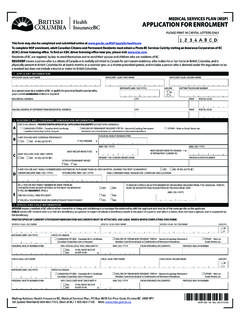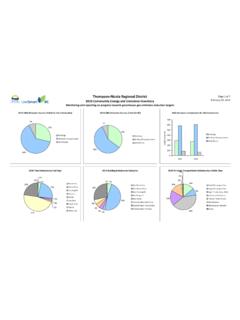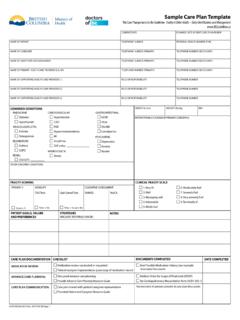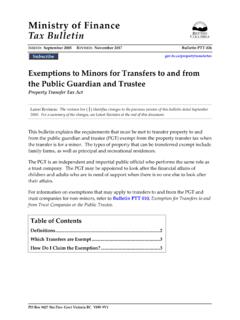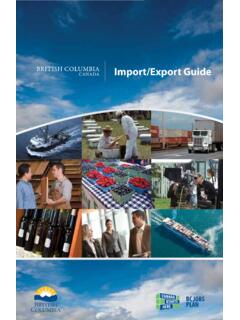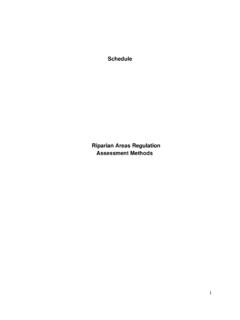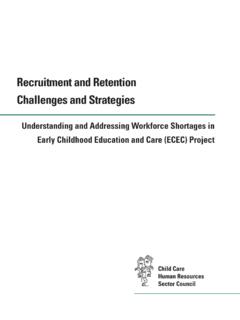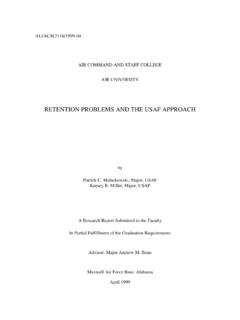Transcription of ON IMMEDIATE RECRUITMENT AND RETENTION …
1 December 11, byREPORTON IMMEDIATE RECRUITMENT AND RETENTION CHALLENGESTHE MINISTER S TASK FORCE2 Along the Big Cedar TrailCheakamus CentrePhoto Credit: David Nanuk PhotographySchool District 443 TABLE OF SUMMARYCLARIFYING THE PROBLEM RECRUITMENT AND RETENTION EFFORTS UNDERWAYA ppendix 1 - Chart of ReccomendationsAppendix 2 - Terms of Reference Appendix 3 - Workplan Appendix 4 - Rural and Remote Workforce Sustainability Fund042122241215 TASK FORCE DELIBERATIONS AND 5 - The New Teacher Mentorship Program 274 EXECUTIVE SUMMARYThe Minister s Task Force on IMMEDIATE RECRUITMENT and RETENTION challenges was charged with two objectives: Verify the extent of the current educator workforce challenges and quantify those challenges ,and; Make recommendations for IMMEDIATE actions to address those specific report is tabled with the Minister of Education to present the process, findings, and recom-mendations in fulfillment of these objectives.
2 The Terms of Reference and meeting schedule for the Task Force are included in Appendices 2 and 3. The Task Force is comprised of executive-level experts representing the key workforce stakehold-ers in the education sector, including school districts, teachers, post-secondary institutions, and human resource management. Members brought a rich and diverse cross-section of perspectives, evidence, and ideas to Task Force deliberations and in doing so, represent the major levers required for successful RECRUITMENT and RETENTION of educators in the province. Task Force Membership: Ken Dawson, Executive Director, Public Sector Employers Council Secretariat (PSEC Secretariat) Glen Hansman, President, British Columbia Teachers Federation (BCTF) Kris Magnusson, Dean, Faculty of Education, Simon Fraser University Gina Niccoli-Moen, Superintendent, School District 41, Burnaby Janet Stewart, Chief Operating Officer, British Columbia Public School Employers Association (BCPSEA) Chris van der Mark, Superintendent, School District 54, Bulkley Valley The Task Force was facilitated by Keith Godin, Assistant Deputy Minister - Governance and Analyt-ics, Ministry of Education.
3 The Task Force was also supported by external expertise, such as techni-cal staff and reports commissioned from the Ministry of Education, as well as submissions by other partners such as the British Columbia Principals' and Vice-Principals' Task Force recognizes that as remedies for exceeding MOA class size and composition require-ments are implemented, further strain on non-enrolling teachers and TTOC lists is expected. The Task Force additionally identified RETENTION and a rise in turnover as a potential challenge, partly due to an aging workforce. Recommendations for action are most effective when exercised in a particular context for the intended purpose, noting what may have worked in another jurisdiction, or another time, may not be applicable to British Columbia s public education system in the 2017/18 school year.
4 Key aspects of context considered by the Task Force, and discussed more broadly in the Key Context component of this report, implementation of the MOA exacerbated class size and enrolment is increasing, but is uneven across the the demand for teachers requires addressing more than RECRUITMENT and demand is met by supply from British Columbia, across Canada, and to a lesserextent within the collective agreement that may impact RECRUITMENT and RETENTION ofteachers are outside the scope of the Task Force F. Province-wide supply of teachers meets province-wide demand for teachers but thedistribution to specialty positions and regions may not meet district level districts have statutory responsibility to hire and manage staff in their districts5In their review of the available evidence, the Task Force found that the 3,700 public school teaching positions funded by the Ministry were a result of the class size and composition limits set out in the Memorandum of Agreement (MOA).
5 When combined with student enrolment increases in 2017/18, they represented a workforce challenge for the provincial education system. Reports from school districts indicate that the vast majority of that hiring had been completed, which led the Task Force to conclude that the consequences of the unprecedented hiring was the central issue for the Task Force to address. Namely, but not necessarily limited to: Difficulties filling vacancies in certain specialty teaching positions were exacerbated; Smaller, and in some cases, significant reductions in the number and availability of TeachersTeaching on Call (TTOC), and an impact on non-enrolling teachers who were reassigned to fillvacancies; Worsening pre-existing shortages of teachers in rural and smaller districts across the Task Force acknowledges that work has been underway around British Columbia in Boards of Education and partner groups to examine educator workforce challenges as well as imple-ment actions to address pressures resulting from the implementation of the MOA.
6 The Task Force made efforts to leverage these initiatives when considering its recommendations, including the Aboriginal Post-Secondary Education Partners' Table, the French Education Stakeholders' Advisory Committee, the Make a Future initative, and the post-secondary institutions consideration of workforce challenges , including examining barriers to rural RECRUITMENT and placement of teachers. Notwithstanding these complementary initiatives, a point of emphasis for the Task Force was that the province's education system would benefit from a comprehensive examination and development of a training and employment strategy supported with improved data and fore-casting, especially as it relates to demand for specialty positions and career pathways for teachers such as attrition and transitions between teaching positions.
7 With that in mind, the Task Force identified some possible medium- and long-term actions for future consideration. The Task Force s IMMEDIATE recommendations are a practical list of actions where implementation can begin promptly to address current challenges . Recommendations will further prepare a foundation to more systemic measures as required to address workforce challenges in British Columbia s public education system:23456 Establish a Province-Wide RECRUITMENT and RETENTION FundDevelop Regional Profiles and RECRUITMENT Strategies Increase Support and Capacity for School Districts' Human Resources Increase the Number of Graduates in Positions under PressurePromote Rural Practica PlacementsSupport Teacher Mentorship70-1,000-500 Table 1: NET CHANGE PUBLIC TEACHERS FROM ENROLMENT AND CLASS SIZE COMPOSITIONKEY CONTEXTD uring the deliberations to verify the extent of teacher shortages, it became apparent to the Task Force that there are a number of considerations that provide important context in which the recommendations for actions will be the implementation of the moa exacerbated CLASS SIZE AND COMPOSITIONP resently, there are approximately 46,000 teachers employed in the province s 1,566 public schools.
8 The MOA established smaller class sizes starting in the 2017/18 school year. Without the impact of the MOA, changing student enrolment was the most significant driver of the demand for the number of teachers; noting that the type of teachers and skill sets varies by district and school. In considering the years with overall student enrolment increases (past and future), approximately 300 more teachers are required (see Table 1). Prior to the implementation of the MOA, there were many job postings for teaching positions and several long-standing postings suggesting acute shortages for some specialized implementation of the class size and composition limits in the MOA combined with student enrolment increases added 3,700 new positions. The number of teaching positions exacerbated both pressures for classroom and specialized positions.
9 For example, prior to the MOA, a long-standing vacancy for a Teacher Counsellor; after implementation of the MOA, that district had two vacancies for Teacher Counsellors. Therefore, the MOA merely deepened a pre-existing RECRUITMENT class size composition requirement became effective in 2017/18B. student enrolment is increasing, but is uneven across the provinceIn 2016/17, the overall student enrolment grew by approximately ; however, it is important to note that the overall growth in student enrolment is not uniform across the province, resulting in a range of demand for teachers. From 2015/16 to 2016/17, prior to the MOA, some school districts experienced an increase of 25-percent in the number of teachers. At the same time, other districts experienced a decrease in the number of teachers by 15-percent.
10 Also noting changes can increase or decrease across districts from year-to-year, this variation highlights the need for teacher training programs to be responsive and nimble, and for districts to maximize all sources of teachers from graduates of British Columbia and Canadian post-secondary institutions to experienced teachers from other provinces to those new to Canada. 85 BCMF PUBLIC SCHOOL TEACHER EMPLOYMENT GROWTH2015/2016 to 2016 increase+330 FTEC onseil Scolaire Francophone schools are across the province. The numbr of employed teachers increased by the demand for teachers requires addressing more than RECRUITMENT and retentionRecognizing teaching quality is one of the most significant drivers of student outcomes [1], the Min-istry engaged Learning First [2] a global organization of researchers, consultants, policy advisors and teachers committed to education reform.
